Door Closers
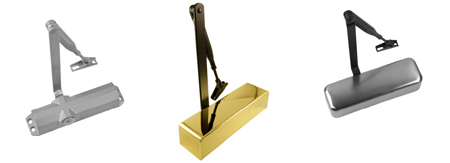
Click here to view our range of Door Closers
Door closers are mainly used in commercial and public buildings but may also be used around the home where circumstances make their use desirable. They have a variety of uses and applications one of the main ones being to keep a door closed to limit the spread of fire and draught throughout a building. There are many different types of door closer available ranging from the simplest gate spring up to the more industrial floor springs. This FAQ looks at the overhead door closer which is by far the most commonly used type.
Q. There are different strengths of overhead door closer - how do I know which one to choose?
A. Overhead door closers are manufactured with either different or adjustable strengths to cater for the size and weight variation of different doors. The bigger and heavier the door, the greater the force required to close it. This force is usually designated by assigning the closer with a number value between 1 and 7 where the higher the number indicates a larger capacity of closer. The following chart shows the test door mass/size for the seven identified grades under the BS EN 1154 classification (a recognised standard for classifying door closers).
If a door closer is being fitted to a fire door, then it is usually recommended that a minimum of a size 3 is fitted. Air pressure on the door from wind is also a consideration which could lead to a higher size number than the actual door weight being needed. Restrictions in the design of certain buildings may lead to arrangements where special brackets are needed to mount the door closer (see next answer). The use of these brackets can often weaken the strength of a closer and require that a size higher than that needed for the weight of the door is necessary. Some types of door closers can vary their strength number by altering the position of the closer on the door by means of moving it along a bracket. This is convenient where the size required is uncertain and facilitates a greater range of adjustment at the time of fitting. Typically these closers can be designated 2-4 size or even 2-6 size in certain circumstances.
Q. Are all overhead door closers fitted to the door in the same way?
A. No, there are various ways of fitting a door closer and this is generally dictated by the door arrangement the closer is to be fitted to. The three most popular applications are listed below, if you have a special application situation not shown here then it is best seeking the manufacturer's advice. a) The standard application most commonly used is called 'figure 1'. This is where the closer is fitted to the opening face of the door on the hinge side. When fitted in this way, the arms of the closer project outward - see diagram 1 below. b) The second application shown below in diagram 2 is known as 'figure 66', where the closer is fitted to the closing face of the door opposite the hinge side. An extra bracket (figure 66 bracket), normally supplied with the closer, is fitted to the arms which run parallel to the door frame. This application is normally used on outward opening external doors where it is not desirable for the closer to be fitted to the outside of the building. c) A further application known as 'figure 61' is used where the closer body is inverted and fitted to the head frame rather than the door itself. This application can also be used on outward opening external doors, particularly those where the door only has a narrow top rail, not wide enough to house the body of the closer. See diagram 3 below.
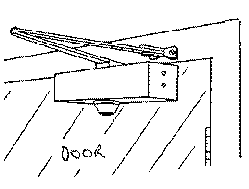
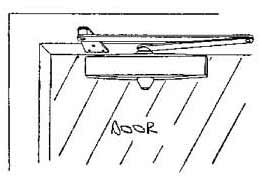
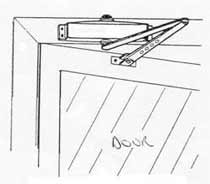
Q. I don't want the door closer to be seen, is there any way of doing this?
A. Yes there are door closers available that can be concealed into the top of the door. Although this is a great way of 'hiding' the closer, a large part of the door must be cut away to house the body and this will reduce the fire integrity of the door. It is always a good idea to check with the fire prevention officer that this type of door control is suitable. There is also a type of closer that will fit in the side of the door with the mechanism contained inside the door. This type is known as the Perko™ door closer and there is a hydraulic version known as the Perkomatic™ which offers better control of the closing speed and latch action (the force required to overcome the door latch).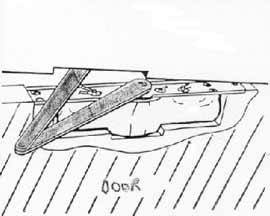
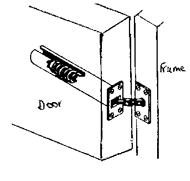
Q. Hold Open - I want to be able to hold my door open at 90 degrees, how can I do this?
A. There is a device which can be used in conjunction with a door closer called a 'stand open arm'. When this arm is fitted with the door closer, your door will remain open at a preset angle until it is closed manually. Alternatively there are some door closers which have such a device incorporated into the mechanism. Be aware of fire regulations when fitting these devices as they may not be allowed by Fire Officers on specific doors within a building for obvious reasons!
Q. Delayed Action - My premises need wheel chair access - will the doors close on them too quickly?
A. For this type of situation it is best choosing a door closer which has a 'delayed action'. This allows the door to remain open for a preset period of time before closing at an adjustable speed. Such a system will allow people in wheelchairs or the elderly to get through the door before it starts to close. This is also useful in areas where trolleys are used. Your Fire Officer will prefer this to the hold open device described above, but check this with your local fire authority first.
Q. Back Check - The wind catches my door and throws it open, how can I prevent this?
A. Door closers can be supplied with an optional 'back check' action included. This back check action provides resistance within the door closer to prevent the door leaf from being thrown open . This prevents damage to the door, door frame and door handles caused by people kicking or throwing the door open and also by the door being violently blown open by the wind. The angle and resistance of the back check can be varied according to your requirements. When using a door closer with a back check facility it is worth remembering that this facility puts extra strain on the door hinges - remember to allow for this when choosing your hinges!
Q. What is meant by the BS EN 1154 classification for door closers?
A. This standard classifies door closers by means of a 6 digit coding system. The digits relate to a particular feature of the product measured against the standards performance requirements. The meaning of these digits is as follows:
1st Digit - Category of use: Grade 3 is for doors closing from at least 105° and Grade 4 is for doors closing from 180° open.
2nd Digit - Durability: Grade 8 indicates that 500,000 test cycles are completed
3rd Digit - Test door mass/size: This identifies seven grades of power as indicated in the table above.
4th Digit - Fire Behaviour: Grade 0 is not suitable for use on fire/smoke doors, Grade 1 is suitable for use on fire/smoke doors. This feature is assessed outside of BS EN 1154.
5th Digit - Safety: All door closers are required to satisfy the essential requirement of safety in use and then designated Grade 1.
6th Digit - Corrosion resistance: Five grades are identified according to BS EN 1670. Grade 0 = no defined resistance, Grade 1 = mild resistance, Grade 2 = moderate resistance, Grade 3 = high resistance, Grade 4 = very high resistance.
A door closer with the following marking therefore would denote a closer opening to at least 105° with a power size of 4 which is suitable for a fire door inside a building: 384110
Q. Why do door closer prices vary so much?
A. Prices will vary between manufacturers and of course you have to take into consideration any special features that you require such as 'back check' or 'delayed action' (described above). The finish of the closer body may also add to the price you pay. Most units are commonly available in a standard silver finish, but if you are matching up to other door hardware you may wish to consider brass, chrome, stainless steel, satin chrome or any one of the many colours available. The best value is achieved by purchasing the closer that suits your needs!
DISCLAIMER Door Furniture Direct makes every effort to ensure that the information contained in our FAQs is correct and accurate. We can however accept no responsibility for any errors or omissions or their subsequent effects. Indeed if you find any please let us know, we appreciate any advice or comments to improve these pages.
